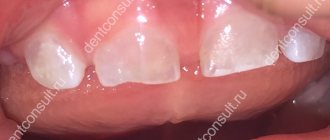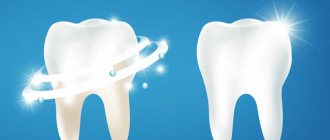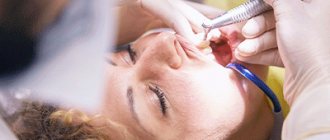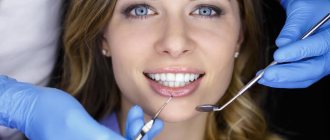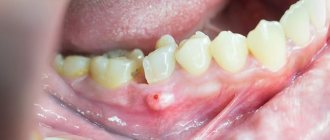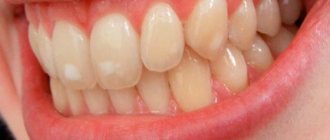Author: Brodsky Sergey Evgenievich Deputy Chief Physician, Candidate of Medical Sciences in the specialties: dentistry and medical microbiology A broken tooth is the cause of discomfort during meals, which can lead to the development of inflammatory processes in the hard and soft tissues of the tooth, root and gum. Therefore, if a defect is detected, you should immediately consult a dentist, who will select the correct method for restoring the tooth.
Causes of tooth fracture
Part of a tooth can chip or break as a result of exposure to internal and external factors. The first group of reasons include:
- pathologies associated with disruption of intrauterine development of surface and hard tissues of the tooth;
- metabolic disorders associated with impaired absorption of calcium, magnesium and phosphorus, provoked by rickets suffered in childhood, the use of diuretics, and poor nutrition;
- diseases of the digestive tract, accompanied by changes in the acidity of saliva, which has a destructive effect on tooth tissue.
A tooth in the gum can break under the influence of a number of external factors, including:
- injuries to the skull and jaw during a fight, road accident;
- tooth injury during dental procedures;
- eating solid foods;
- thermal injury due to the simultaneous consumption of cold and hot food and drinks;
- advanced carious processes;
- incorrect structure of the dentition.
Symptoms of a tooth fracture
Injuries often go unnoticed, as a result of which the floor of a tooth that is deprived of sensitivity is broken. Also, the clinic may be absent if there is minor damage to the enamel. Such defects can only be determined visually during an independent examination of the oral cavity.
In other cases, when a tooth is fractured, a person experiences pain. A pain syndrome that limits the movement of the lower jaw occurs when a tooth breaks at the root, and the fragments injure the soft tissue of the gums. A tooth broken under the gum often causes loosening of adjacent units, bleeding and speech impairment.
Deputy Chief physician Sergey Evgenievich Brodsky
Sign up for a free consultation
+7
First aid for a fracture
When a tooth breaks and hurts, you should immediately seek help from a dentist. Before examination by a specialist, doctors at the Partner-Med clinic recommend providing first aid, namely:
- rinse your mouth with clean boiled water at room temperature or warm chamomile infusion;
- apply and firmly clamp the application with cotton wool or a bandage in case of bleeding;
- take a pain reliever with an anti-inflammatory effect (Analgin, Paracetamol, Ibuprofen) if there is severe pain;
- apply a cold compress to the sore spot;
- immobilize the jaw with a tight bandage if injury is suspected.
Complications
If the front upper or lower teeth are broken, this causes, first of all, aesthetic discomfort, as the smile changes, articulation and clarity of diction are impaired. It can often provoke the development of psychological problems and complexes. A broken chewing tooth disrupts the food processing process. Large particles of food entering the stomach lead to disruption of its functions. The development of pathological processes is accompanied by a feeling of discomfort in the abdominal area and heartburn. A broken tooth under the crown causes displacement of the prosthesis, deformation of adjacent units, or injury to the gums. There is also a danger of developing infectious and inflammatory processes as a result of the penetration of pathogenic flora into injured tooth and gum tissues.
Ask a question!
8
We'll call you back in 1 minute
Diagnostics
After visiting a dental clinic, a specialist relieves pain and conducts a visual examination of the oral cavity, during which it is possible to determine:
- degree of damage to hard dental tissues;
- dislocation of adjacent teeth;
- tissue necrosis;
- penetration of blood into the tooth cavity.
To obtain a complete clinical picture, assess the condition of the roots of a broken tooth, the degree of displacement and damage to the nerve fibers, an x-ray examination is performed. In case of severe injuries, an orthopantogram or electroodontometry is performed to determine the condition of the dental system and assess the viability of the pulp.
Why Teeth Chip – Potential Causes of Injury and Crown Failure
Enamel is considered the hardest tissue in the body. But even chips can appear on it, and there are many possible reasons for this. A chip is an injury in which the integrity of the crown is compromised. The damage may be very minor, even unnoticeable. But in other cases, the chip affects not only the enamel, but also the dentin.
If a tooth breaks off near the gum, such a defect cannot be ignored. Moreover, in case of large-scale damage, the pulp may also be injured, and this will inevitably provoke severe piercing pain - you need to see a doctor as soon as possible.
A chip is an injury in which the integrity of the crown is compromised
As a rule, teeth are injured as a result of mechanical impact. For example, the front incisors and canines are at high risk - they can easily be damaged if you fall or get hit. Molars more often chip off during meals, when chewing solid foods. A cracker, a fish bone, or, for example, a nut shell can injure the chewing crown. However, there are other reasons that can provoke such trouble:
- insufficient hygiene, abundant plaque and hardened deposits - the active activity of pathogenic microorganisms in this case leads to the gradual destruction of hard tissues, the development of caries and pulpitis,
- the habit of biting off thread with teeth, cracking nut shells, gnawing seeds,
- demineralization of enamel - as a result of systemic failures within the body, hormonal changes, pathological and age-related changes,
- incorrect bite – leads to uneven distribution of the chewing load, which causes crowns to wear down and chip, which are subject to increased pressure,
- consequences of dental treatment - after depulpation, that is, removal of the nerve, the tooth becomes “dead”. This means that it is deprived of constant replenishment, which is why it darkens and becomes brittle. Therefore, chips on pulpless incisors and molars are not uncommon.
Improper dental treatment can cause a problem.
If the enamel is healthy and strong, it will be quite resistant to mechanical stress, temperature and chemical factors. But if the top protective layer has weakened due to constant traumatic exposure, sudden temperature changes in food and drinks, hormonal imbalances, deficiency of vitamins and microelements, or systemic pathologies, it will be more susceptible to cracks and chips.
How to restore a broken tooth?
What to do if a tooth is broken in half vertically?
If the wall of a tooth is broken, the dentist tries to save one of the roots if there is a fracture of a molar that has several processes. To do this, root canal treatment is performed and removal of the appendage, which cannot be saved. Next, a crown is installed in place of the broken tooth wall.
What to do if a tooth is half broken?
If a tooth is broken in half and the chip is horizontal, the doctor evaluates the condition of the tooth and root system. A broken tooth can be repaired using composite resin for minor chips or removed for significant decay. After removing the unit, the dentist prescribes an implantation procedure with the installation of a pin.
What to do if a tooth breaks but the root remains?
If a tooth is broken and the root remains in the gum, based on x-ray data, a decision is made to preserve or remove the root.
When removing the root, the dentist offers two options for restoring the unit:
- dental implantation with the installation of a titanium pin;
- installation of adhesive bridges under a broken tooth with micro-locks on the back walls of supporting teeth.
If the size of the preserved stump is at least 3 mm, and the thickness of the remaining tooth walls is at least 1 mm, restoration is carried out using:
- filling and covering with a crown to restore the anatomical structure;
- restorations by implanting a fiberglass pin, filling and installing a crown;
- stump inlay covered with a crown.
What can you do if your front tooth is broken?
If the front tooth is broken in half, in the presence of a base, the doctor performs a build-up that will not only restore the functionality of the unit, but also restore the aesthetic appearance of the smile.
This restoration method is only possible when the broken front tooth is not affected by caries. In other cases, prosthetics are prescribed. Ask us your question DIRECTLY!
+7
DECIDE! They will definitely help you here!
What to do if your front tooth is broken at the root?
If a front tooth is broken at the root, the dentist always uses the most gentle techniques possible and tries to save the tooth if possible.
When is a tooth and root removed?
A broken wisdom tooth and a broken back tooth that is not involved in chewing processes are subject to removal. Doctors recommend removing a broken tooth if part of the hard tissue and root system is damaged, there are pronounced putrefactive processes and there is no possibility of restoring the tooth. The root subject to inflammatory and putrefactive processes, as well as the broken root of the front and chewing tooth, which cannot be restored, must be removed. The procedure is carried out using ultrasound after opening the gums. In difficult cases, the root is divided into several parts and then removed. After removing the broken tooth, a crown is installed.
Prevention
To prevent tooth fracture, specialists at the Partner-Med dental clinic recommend following the following prevention methods:
- undergo an annual dental examination;
- promptly treat caries and other dental diseases;
- Healthy food;
- replenish calcium deficiency with a course of vitamin-mineral complex;
- brush your teeth twice a day;
- After eating baked goods and sweets, rinse your mouth with clean water.
A broken tooth is a problem that anyone can face. Dentists at the Partner-Med clinic will help you choose the most gentle option for treating and restoring a broken tooth.
Request a call back or dial our number!
+7
This phone call does not obligate you to anything. Just give us a chance and we will help you!
Just pick up the phone and call us!
+7
We will definitely make you an offer that you cannot refuse!
What complications can there be?
Sometimes patients deliberately postpone visiting a doctor if the injury does not cause them the slightest discomfort. After all, a defect may not be too noticeable, but this does not mean that it can be ignored. Hard tissues will continue to deteriorate, and soon, in such conditions suitable for this, active pathogen activity will begin. Then caries, pulpitis, periodontitis - at this rate, after a while you can lose a tooth.
There are other consequences too. For example, sharp carved crowns can injure the inner surface of the cheeks, which can lead to infection through scratches and the development of chronic stomatitis. Therefore, the problem cannot be ignored, even if the damage is minor and does not in any way affect the appearance of the smile. The sooner you see a doctor, the easier and faster the doctor will be able to eliminate the defect.
Example 2. Chronic periodontitis
Chronic periodontitis with the presence of a large cyst or granuloma, as well as with difficult-to-pass root canals filled with dense cement-like material.
Chronic periodontitis is an inflammation of the tissues surrounding the root of the tooth. Microbes in the bone tissue that enter through the root canals lead to the destruction of the bone around the root, creating a cavity filled with bacteria, granulation tissue and, sometimes, pus (i.e., a cyst or granuloma is formed).
If the size of the cyst (or granuloma) is small, and it is located at the very tip of the root, you can try to “save” the tooth using a conservative method (unseal the root canals, clean them, apply an antiseptic for a while, then hermetically seal the canals and restore the crown part of the tooth ).
If the size of the cyst is significant or it is located along the lateral surface of the tooth root (or between the roots), and also if it is not possible to unfill the root canals and it is impossible to perform a tooth-preserving operation, then the best option is tooth extraction.
After all, periodontitis, like any chronic source of inflammation, causes harm to the entire body (microbes, getting from the site into the blood, can multiply in other organs and cause autoimmune processes).
In addition, the cost of labor-intensive therapeutic treatment of periodontitis is usually comparable to tooth extraction and subsequent implantation.
